Quantification and Evaluation of Water Requirements of Oil Palm Cultivation for Different Climate Change Scenarios in the Central Pacific of Costa Rica Using APSIM
Abstract
1. Introduction
2. Materials and Methods
2.1. Study Area
2.2. Soil Physical Parameters
2.3. Climate Data
2.4. Climate Change Scenarios (CCS)
2.5. APSIM Simulation Process
3. Results
3.1. Selection of Study APBs
3.2. Soil Physical Parameters
3.3. Climate Variables
3.4. Climate Change Scenarios (CCS)
3.5. APSIM Model Calibration
3.6. Effects of Climate Change on Oil Palm Crop Production
3.7. Oil Palm Water Requirement under the CCSs
4. Discussion
5. Conclusions
Author Contributions
Funding
Data Availability Statement
Acknowledgments
Conflicts of Interest
References
- Meijaard, E.; Garcia-Ulloa, J.; Sheil, D.; Wich, S.A.; Carlson, K.M.; Juffe-Bignoli, D.; Brooks, T.M. Oil Palm and Biodiversity. A Situation Analysis by the IUCN Oil Palm Task Force, 1st ed.; International Union for Conservation of Nature and Natural Resources [IUCN]: Gland, Switzerland, 2018; ISBN 978-2-8317-1910-8. [Google Scholar]
- Barcelos, E.; De Almeida Rios, S.; Cunha, R.N.V.; Lopes, R.; Motoike, S.Y.; Babiychuk, E.; Skirycz, A.; Kushnir, S. Oil Palm Natural Diversity and the Potential for Yield Improvement. Front. Plant Sci. 2015, 6, 190. [Google Scholar] [CrossRef] [PubMed]
- Instituto Nacional de Estadística y Censos [INEC]. Encuesta Nacional Agropecuaria 2017; INEC: San José, Costa Rica, 2017.
- Cámara Nacional de Productores de Palma [CANAPALMA]. Información Cultivo de Palma Aceitera En Costa Rica; CANAPALMA: Río Claro, Costa Rica, 2017. [Google Scholar]
- Pirker, J.; Mosnier, A.; Kraxner, F.; Havlík, P.; Obersteiner, M. What Are the Limits to Oil Palm Expansion? Glob. Environ. Chang. 2016, 40, 73–81. [Google Scholar] [CrossRef]
- Paterson, R.R.M.; Lima, N. Climate Change Affecting Oil Palm Agronomy, and Oil Palm Cultivation Increasing Climate Change, Require Amelioration. Ecol. Evol. 2018, 8, 452–461. [Google Scholar] [CrossRef] [PubMed]
- Ghini, R.; Bettiol, W.; Hamada, E. Diseases in Tropical and Plantation Crops as Affected by Climate Changes: Current Knowledge and Perspectives. Plant Pathol. 2011, 60, 122–132. [Google Scholar] [CrossRef]
- Paterson, R.R.M.; Kumar, L.; Taylor, S.; Lima, N. Future Climate Effects on Suitability for Growth of Oil Palms in Malaysia and Indonesia. Sci. Rep. 2015, 5, 14457. [Google Scholar] [CrossRef]
- Tani, N.; Abdul Hamid, Z.A.; Joseph, N.; Sulaiman, O.; Hashim, R.; Arai, T.; Satake, A.; Kondo, T.; Kosugi, A. Small Temperature Variations Are a Key Regulator of Reproductive Growth and Assimilate Storage in Oil Palm (Elaeis Guineensis). Sci. Rep. 2020, 10, 650. [Google Scholar] [CrossRef]
- Woittiez, L.S.; Wijk, M.T.V.; Slingerland, M.; Noordwijk, M.V.; Giller, K.E. Yield Gaps in Oil Palm: A Quantitative Review of Contributing Factors. Eur. J. Agron. 2017, 83, 57–77. [Google Scholar] [CrossRef]
- Corley, R.H.V.; Tinker, P.B. The Oil Palm, 5th ed.; Wiley-Blackwell: Hoboken, NJ, USA, 2016; ISBN 978-1-4051-8939-2. [Google Scholar]
- Keating, B.A.; Carberry, P.S.; Hammer, G.L.; Probert, M.E.; Robertson, M.J.; Holzworth, D.; Huth, N.I.; Hargreaves, J.N.G.; Meinke, H.; Hochman, Z.; et al. An Overview of APSIM, a Model Designed for Farming Systems Simulation. Eur. J. Agron. 2003, 18, 267–288. [Google Scholar] [CrossRef]
- Holzworth, D.P.; Huth, N.I.; DeVoil, P.G.; Zurcher, E.J.; Herrmann, N.I.; McLean, G.; Chenu, K.; van Oosterom, E.J.; Snow, V.; Murphy, C.; et al. APSIM—Evolution towards a New Generation of Agricultural Systems Simulation. Environ. Model. Softw. 2014, 62, 327–350. [Google Scholar] [CrossRef]
- Huth, N.I.; Banabas, M.; Nelson, P.N.; Webb, M. Development of an Oil Palm Cropping Systems Model: Lessons Learned and Future Directions. Environ. Model. Softw. 2014, 62, 411–419. [Google Scholar] [CrossRef]
- Holzworth, D.; Huth, N.I.; Fainges, J.; Brown, H.; Zurcher, E.; Cichota, R.; Verrall, S.; Herrmann, N.I.; Zheng, B.; Snow, V. APSIM Next Generation: Overcoming Challenges in Modernising a Farming Systems Model. Environ. Model. Softw. 2018, 103, 43–51. [Google Scholar] [CrossRef]
- Wang, J.; Wang, E.; Liu, D.L. Modelling the Impacts of Climate Change on Wheat Yield and Field Water Balance over the Murray–Darling Basin in Australia. Theor. Appl. Climatol. 2011, 104, 285–300. [Google Scholar] [CrossRef]
- Chen, C.; Baethgen, W.E.; Robertson, A. Contributions of Individual Variation in Temperature, Solar Radiation and Precipitation to Crop Yield in the North China Plain, 1961–2003. Clim. Chang. 2013, 116, 767–788. [Google Scholar] [CrossRef]
- Fayaz, A.; Kumar, Y.R.; Lone, B.A.; Kumar, S.; Dar, Z.A.; Rasool, F.; Abidi, I.; Nisar, F.; Kumar, A. Crop Simulation Models: A Tool for Future Agricultural Research and Climate Change. Asian J. Agric. Extension, Econ. Sociol. 2021, 39, 146–154. [Google Scholar] [CrossRef]
- Zhu, G.; Liu, Z.; Qiao, S.; Zhang, Z.; Huang, Q.; Su, Z.; Yang, X. How Could Observed Sowing Dates Contribute to Maize Potential Yield under Climate Change in Northeast China Based on APSIM Model. Eur. J. Agron. 2022, 136, 126511. [Google Scholar] [CrossRef]
- Okoro, S.U.; Schickhoff, U.; Boehner, J.; Schneider, U.A.; Huth, N.I. Climate Impacts on Palm Oil Yields in the Nigerian Niger Delta. Eur. J. Agron. 2017, 85, 38–50. [Google Scholar] [CrossRef]
- Gaydon, D.S.; Meinke, H.; Rodriguez, D. The Best Farm-Level Irrigation Strategy Changes Seasonally with Fluctuating Water Availability. Agric. Water Manag. 2012, 103, 33–42. [Google Scholar] [CrossRef]
- Dudek, A. Silhouette Index as Clustering Evaluation Tool. In Proceedings of the Classification and Data Analysis. SKAD 2019. Conference of the Section on Classification and Data Analysis of the Polish Statistical Association, Szczecin, Poland, 18–20 September 2019; Jajuga, K., Batóg, J., Walesiak, M., Eds.; Springer: Cham, Switzerland, 2020; pp. 19–33. [Google Scholar] [CrossRef]
- Karna, A.; Gibert, K. Automatic Identification of the Number of Clusters in Hierarchical Clustering. Neural Comput. Appl. 2022, 34, 119–134. [Google Scholar] [CrossRef]
- Silva, P.Y.D.; Fernando, C.N.; Wijethunge, D.D.; Fernando, S.D. Recursive Hierarchical Clustering Algorithm. Int. J. Mach. Learn. Comput. 2018, 8, 1–7. [Google Scholar] [CrossRef]
- Xu, Q.; Zhang, Q.; Liu, J.; Luo, B. Efficient Synthetical Clustering Validity Indexes for Hierarchical Clustering. Expert Syst. Appl. 2020, 151, 113367. [Google Scholar] [CrossRef]
- Instituto Nacional de Innovación y Transferencia en Tecnología Agropecuaria [INTA]. Suelos de Costa Rica Orden Ultisol. Boletín Técnico 1; INTA: San José, Costa Rica, 2016. [Google Scholar]
- Ladino-Tabarquino, G.S.; Arias-Arias, N.A. Comportamiento Del Desarrollo Radicular y Vegetativo de La Palma de Aceite Bajo Diferentes Condiciones de Compactación En Zona Norte; Cenipalma: Bucaramanga, Colombia, 2019. [Google Scholar]
- Vogeler, I.; Lilburne, L.; Webb, T.; Cichota, R.; Sharp, J.; Carrick, S.; Brown, H.; Snow, V. S-Map Parameters for APSIM. MethodsX 2022, 2022, 101632. [Google Scholar] [CrossRef] [PubMed]
- Beretta, A.N.; Silbermann, A.V.; Paladino, L.; Torres, D.; Bassahun, D.; Musselli, R.; García-Lamohte, A. Soil Texture Analyses Using a Hydrometer: Modification of the Bouyoucos Method. Cienc. Investig. Agrar. 2014, 41, 25–26. [Google Scholar] [CrossRef]
- Gómez-Calderón, N.; Estrada-León, R.J. Conservación de Suelos Mediante La Modificación de La Frecuencia de Labranza: Un Caso En Costa Rica. Rev. Cienc. Ambient. 2020, 54, 123–139. [Google Scholar] [CrossRef]
- Hidalgo, H.G.; Alfaro, E.J.; Quesada-Montano, B. Observed (1970–1999) Climate Variability in Central America Using a High-Resolution Meteorological Dataset with Implication to Climate Change Studies. Clim. Chang. 2017, 141, 13–28. [Google Scholar] [CrossRef]
- Hidalgo, H.G.; Alfaro, E.J. Skill of CMIP5 Climate Models in Reproducing 20th Century Basic Climate Features in Central America. Int. J. Climatol. 2015, 35, 3397–3421. [Google Scholar] [CrossRef]
- Yang, L.; Zhong, P.; Zhu, F.; Ma, Y.; Wang, H.; Li, J.; Xu, C. A Comparison of the Reproducibility of Regional Precipitation Properties Simulated Respectively by Weather Generators and Stochastic Simulation Methods. Stoch. Environ. Res. Risk Assess. 2022, 36, 495–509. [Google Scholar] [CrossRef]
- Tseng, S.; Chen, C.; Senarath, S.U.S. Evaluation of Multi-site Precipitation Generators across Scales. Int. J. Climatol. 2020, 40, 4622–4637. [Google Scholar] [CrossRef]
- Schonlau, M.; Zou, R.Y. The Random Forest Algorithm for Statistical Learning. Stata J. Promot. Commun. Stat. Stata 2020, 20, 3–29. [Google Scholar] [CrossRef]
- Lee, K.Y.; Kim, K.H.; Kang, J.J.; Choi, S.J.; Im, Y.S.; Lee, Y.D.; Lim, Y.S. Comparison and Analysis of Linear Regression & Artificial Neural Network. Int. J. Appl. Eng. Res. 2017, 12, 9820–9825. [Google Scholar]
- Wright, J. Estudio Del Potencial Solar En Costa Rica. Uniciencia 2009, 23, 19–40. [Google Scholar]
- Akram, H.; Levia, D.F.; Herrick, J.E.; Lydiasari, H.; Schütze, N. Water Requirements for Oil Palm Grown on Marginal Lands: A Simulation Approach. Agric. Water Manag. 2022, 260, 107292. [Google Scholar] [CrossRef]
- Alvarado Gamboa, L.F. Proyecciones de Cambio Climático Regionalizadas Para Costa Rica (Escenarios RCP2.6 y RCP8.5); Ministerio del Ambiente Energía [MINAE]; Instituto Meteorológico Nacional [IMN]: San José, Costa Rica, 2021; ISBN 978-9977-50-156-7.
- Food and Agriculture Organization of the United Nations [FAO]. Guidelines For Soil Description, 4th ed.; FAO: Rome, Italy, 2006; ISBN 92-5-105521-1. [Google Scholar]
- Rai, R.K.; Singh, V.P.; Upadhyay, A. Chapter 17—Soil Analysis. In Planning and Evaluation of Irrigation Projects: Methods and Implementation; Academic Press: Cambridge, MA, USA, 2017; pp. 505–523. ISBN 978-0-12-811748-4. [Google Scholar]
- Salamanca Jiménez, A.; Sadeghian Khalajabadi, S. La Densidad Aparente y Su Relación Con Otras Propiedades En Suelos de La Zona Cafetera Colombiana. Cenicafé 2005, 56, 381–397. [Google Scholar]
- Sarkar, M.S.K.; Begum, R.A.; Pereira, J.J. Impacts of Climate Change on Oil Palm Production in Malaysia. Environ. Sci. Pollut. Res. 2020, 27, 9760–9770. [Google Scholar] [CrossRef] [PubMed]
- Woznicki, S.A.; Nejadhashemi, A.P.; Parsinejad, M. Climate Change and Irrigation Demand: Uncertainty and Adaptation. J. Hydrol. Reg. Stud. 2015, 3, 247–264. [Google Scholar] [CrossRef]
- Watson-Hernández, F.; Guzmán-Arias, I.; Chavarría-Pizarro, L.; Quesada-Alvarado, F. The Effect of Climate Change on the Water Supply and Hydraulic Conditions in the Upper Pejibaye River Basin, Cartago, Costa Rica. Hydrology 2022, 9, 76. [Google Scholar] [CrossRef]
- Ayt Ougougdal, H.; Yacoubi Khebiza, M.; Messouli, M.; Lachir, A. Assessment of Future Water Demand and Supply under IPCC Climate Change and Socio-Economic Scenarios, Using a Combination of Models in Ourika Watershed, High Atlas, Morocco. Water 2020, 12, 1751. [Google Scholar] [CrossRef]
- Paterson, R.R.M.; Sariah, M.; Lima, N. How Will Climate Change Affect Oil Palm Fungal Diseases? Crop Prot. 2013, 46, 113–120. [Google Scholar] [CrossRef]
- Abubakar, A.; Ishak, M.Y.; Makmom, A.A. Impacts of and Adaptation to Climate Change on the Oil Palm in Malaysia: A Systematic Review. Environ. Sci. Pollut. Res. 2021, 28, 54339–54361. [Google Scholar] [CrossRef]
- Ahmed, A.; Mohd, Y.B.I.; Abdullah, A.M. Oil Palm in the Face of Climate Change: A Review of Recommendations. IOP Conf. Ser. Earth Environ. Sci. 2021, 646, 012065. [Google Scholar] [CrossRef]
- Shanmuganathan, S.; Narayanan, A. Modelling the Climate Change Effects on Malaysia’s Oil Palm Yield. In Proceedings of the 2012 IEEE Symposium on E-Learning, E-Management and E-Services, Kuala Lumpur, Malaysia, 21–24 October 2012; pp. 1–6. [Google Scholar] [CrossRef]
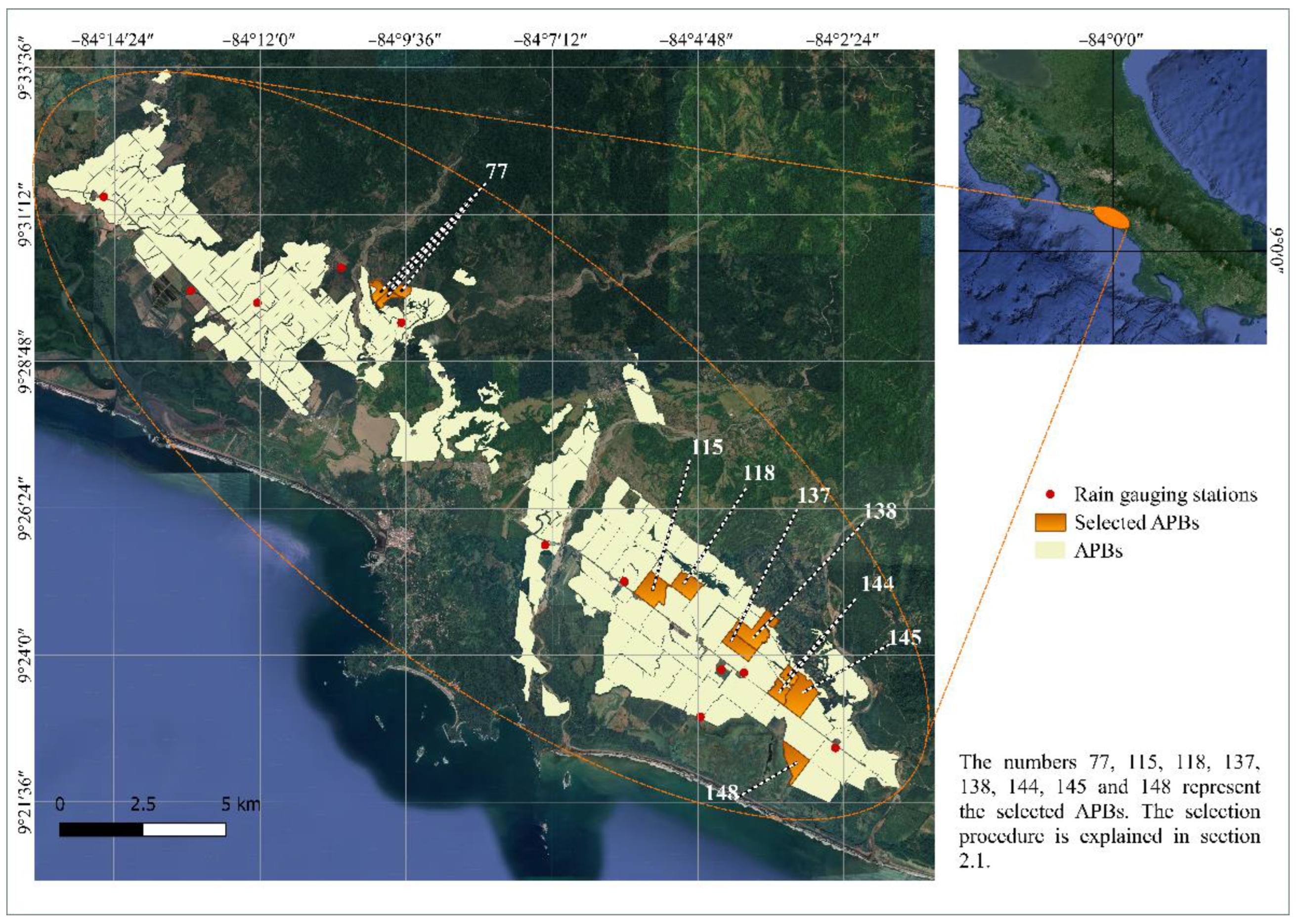
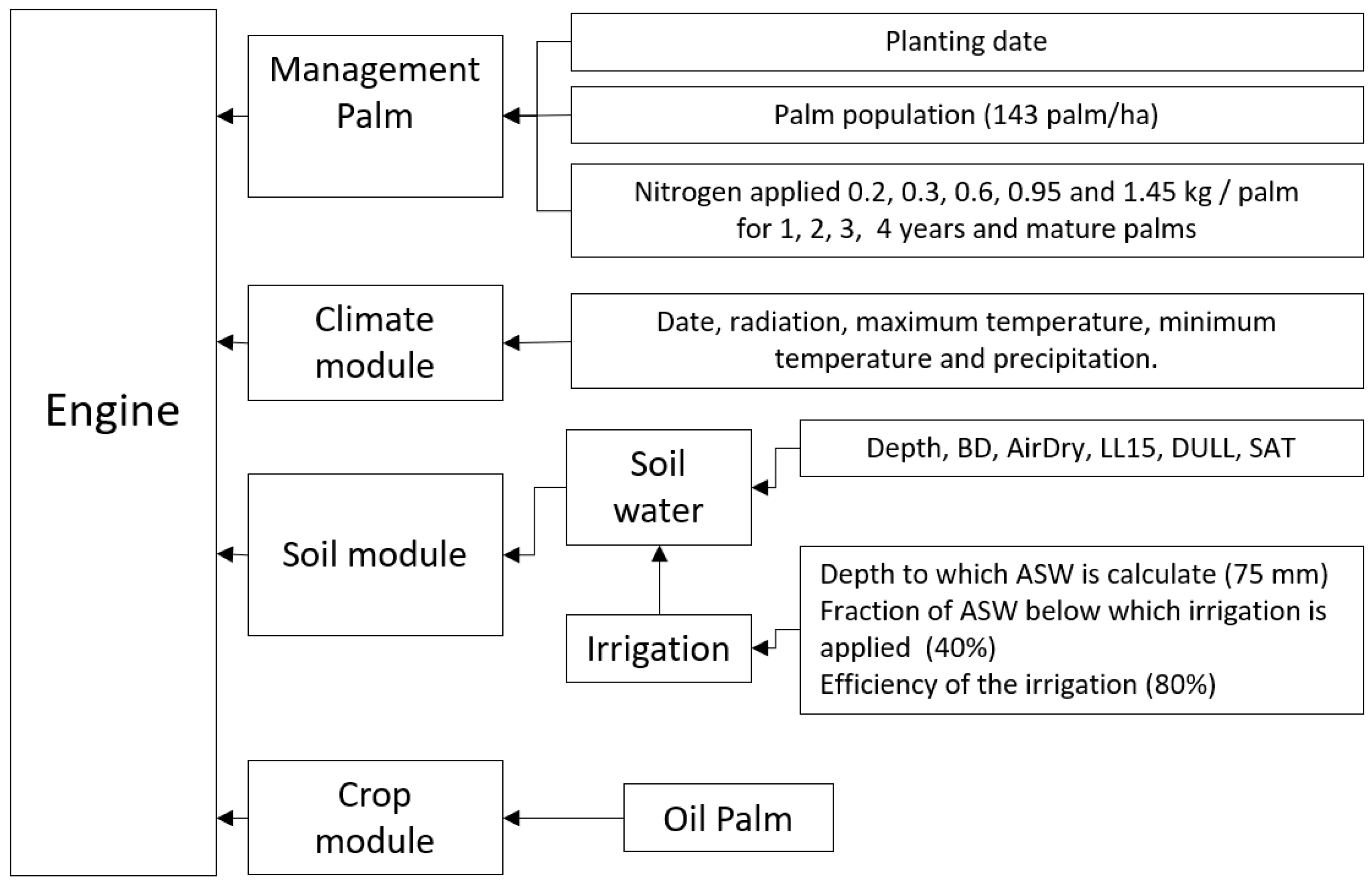

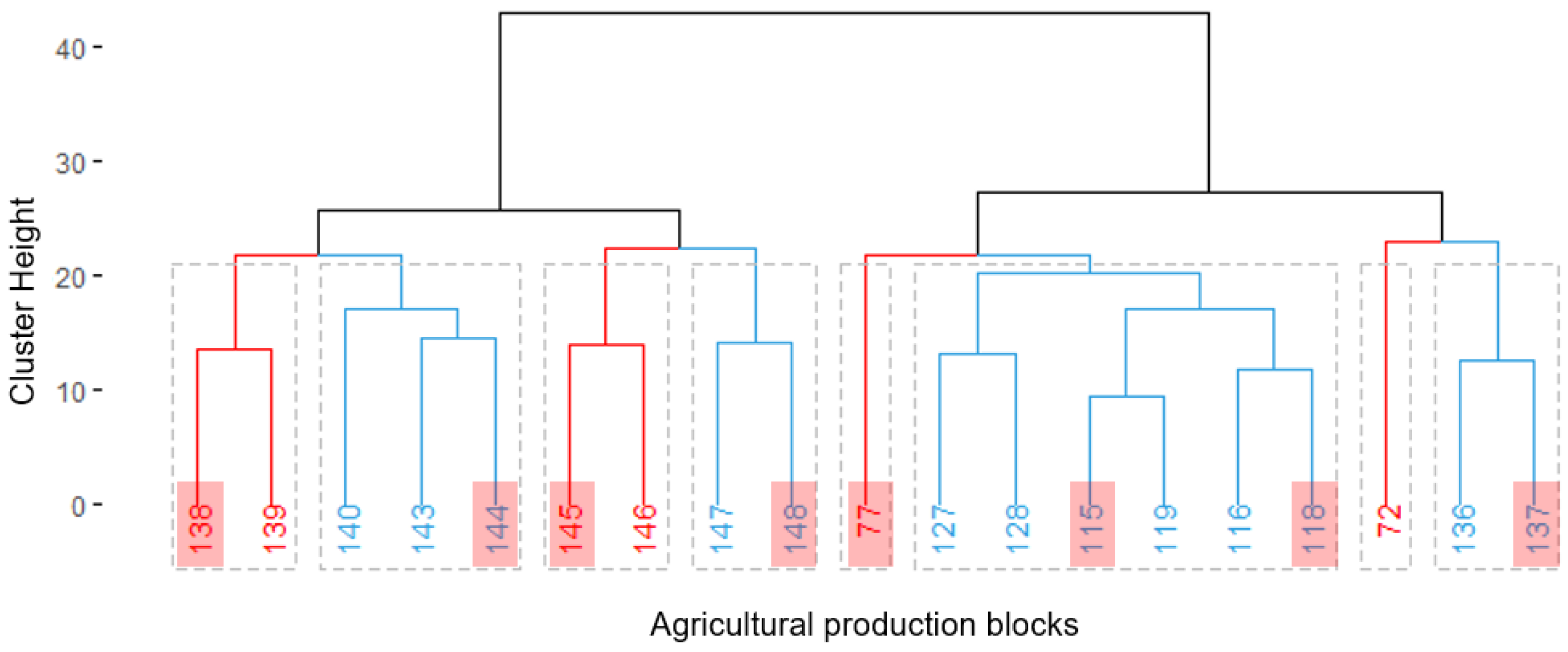


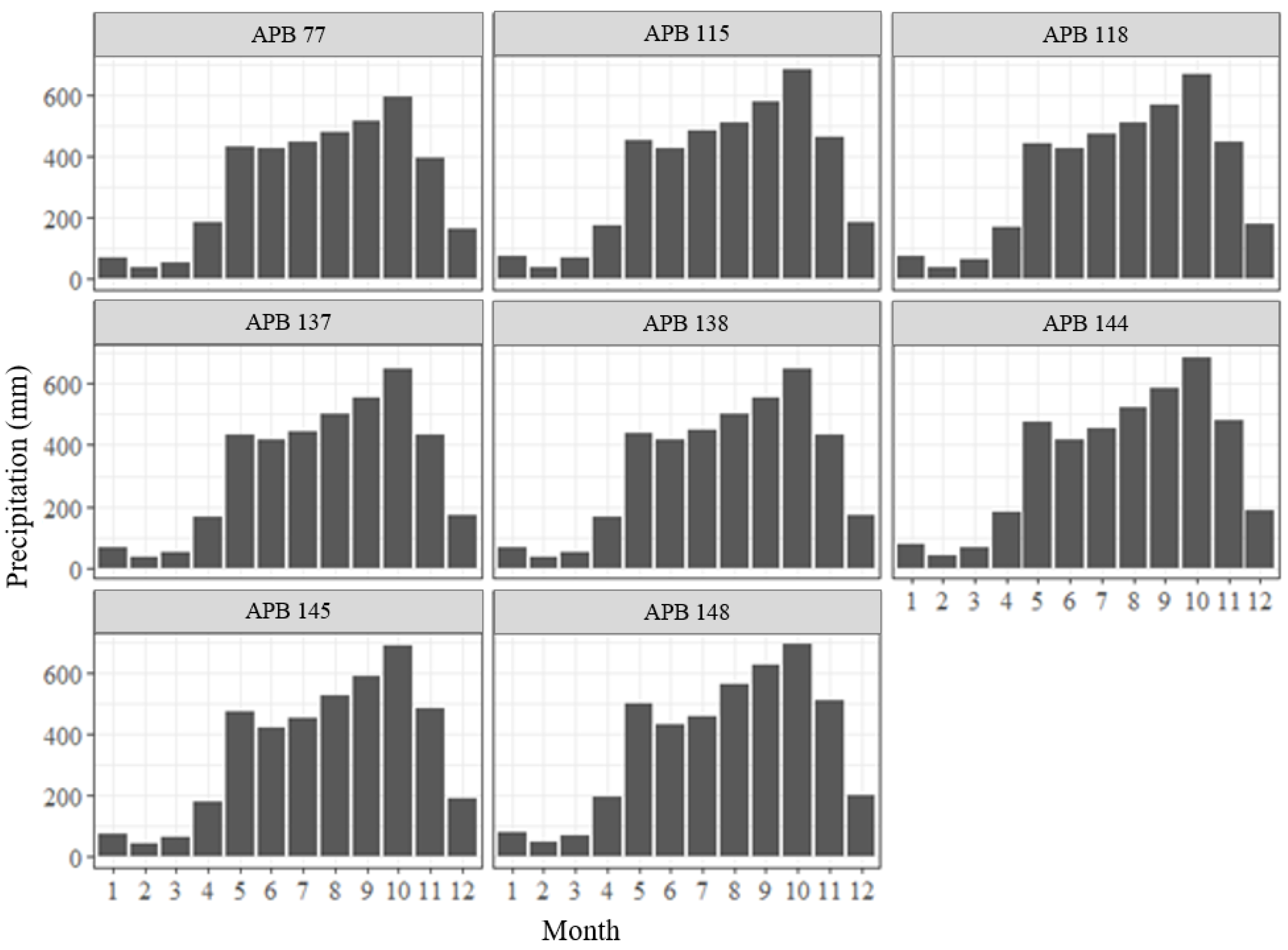
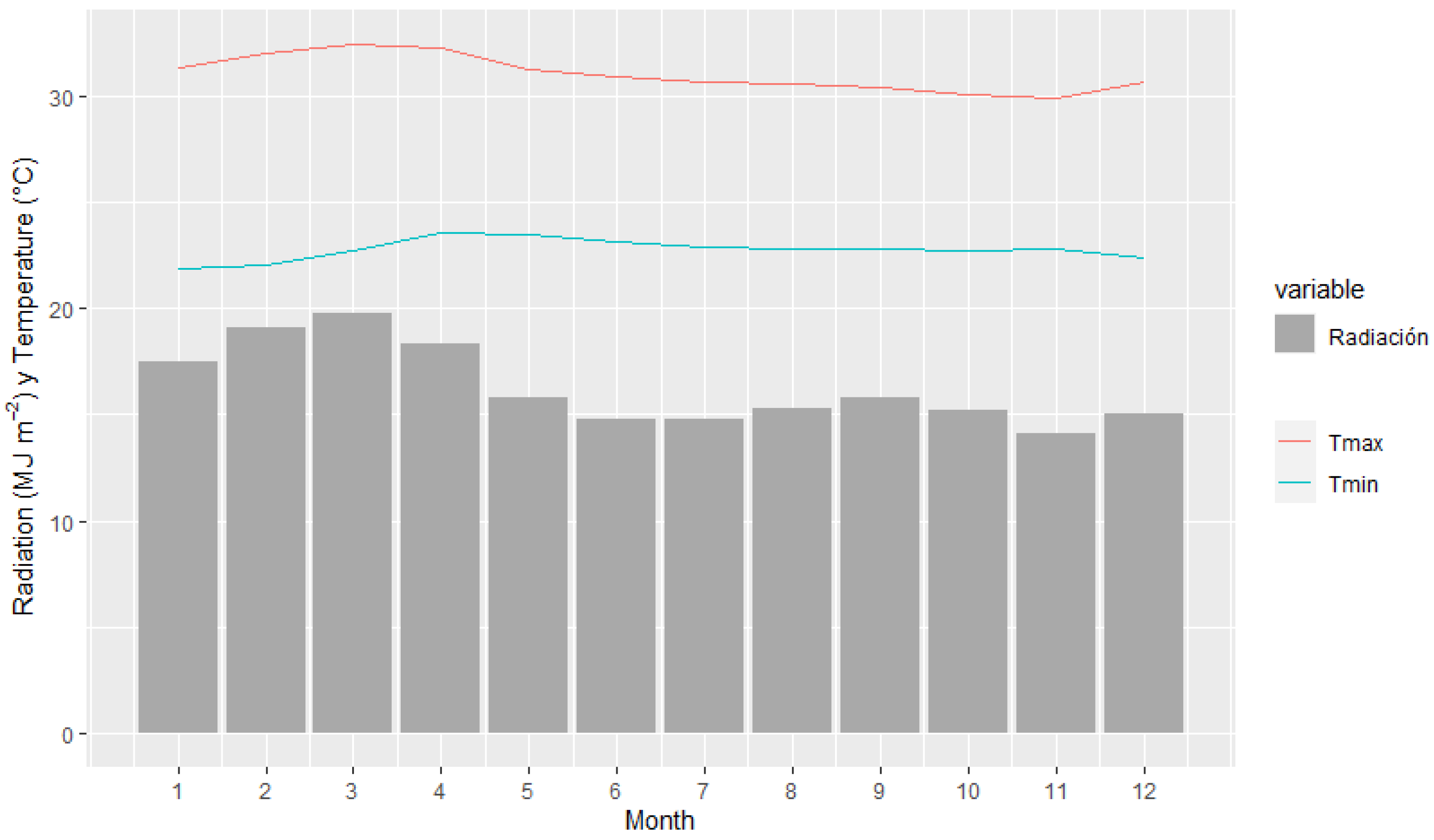
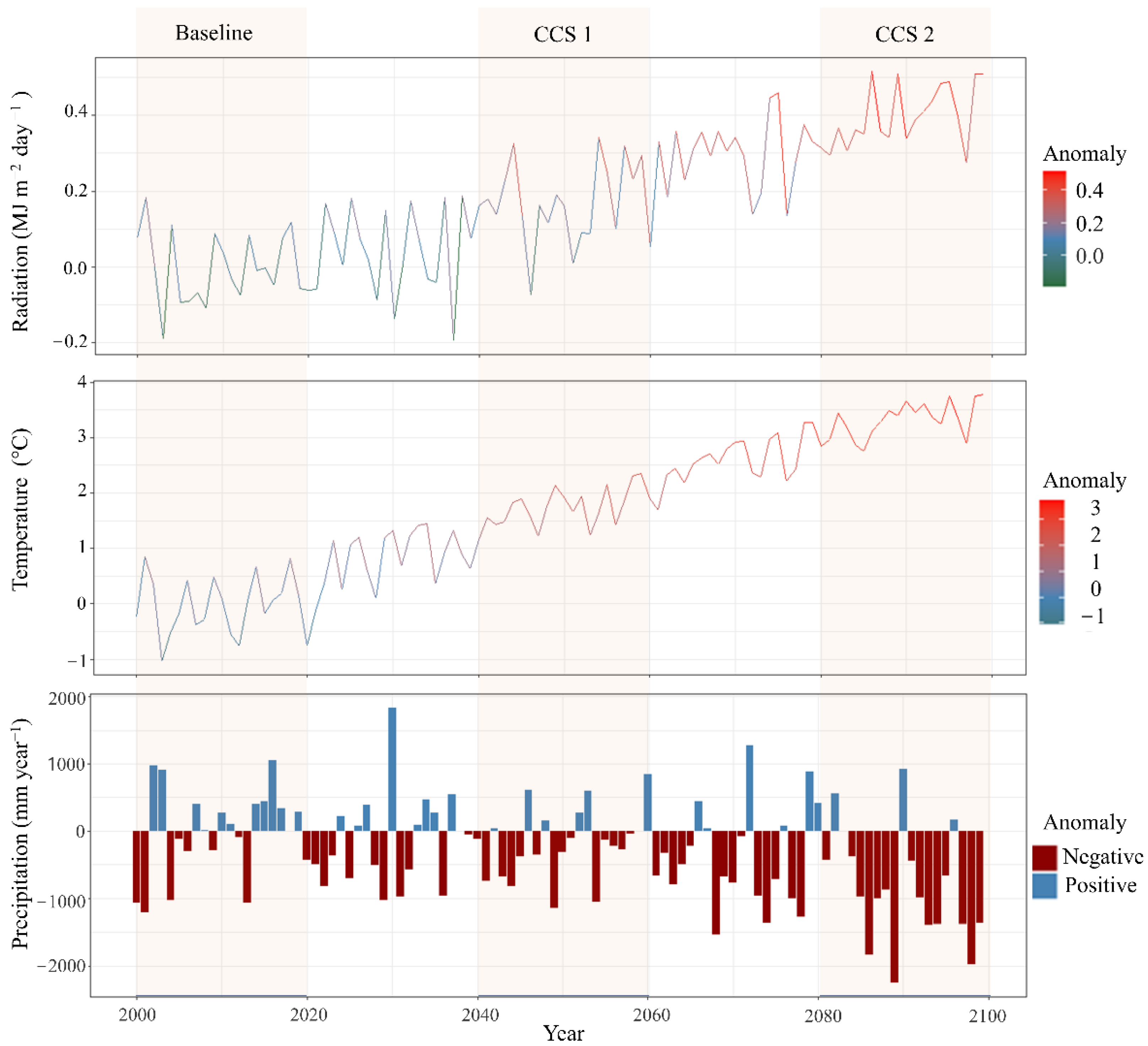
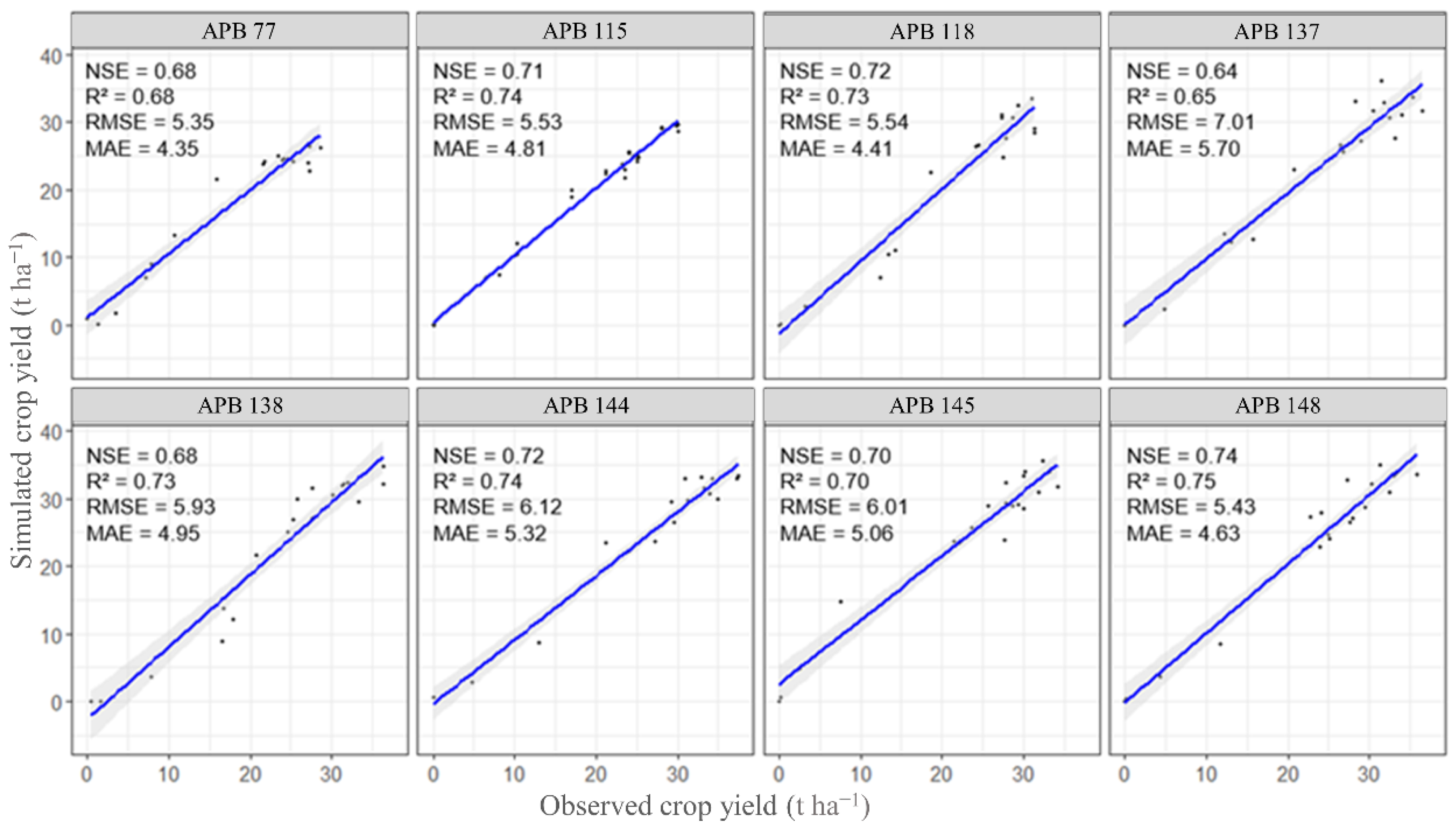
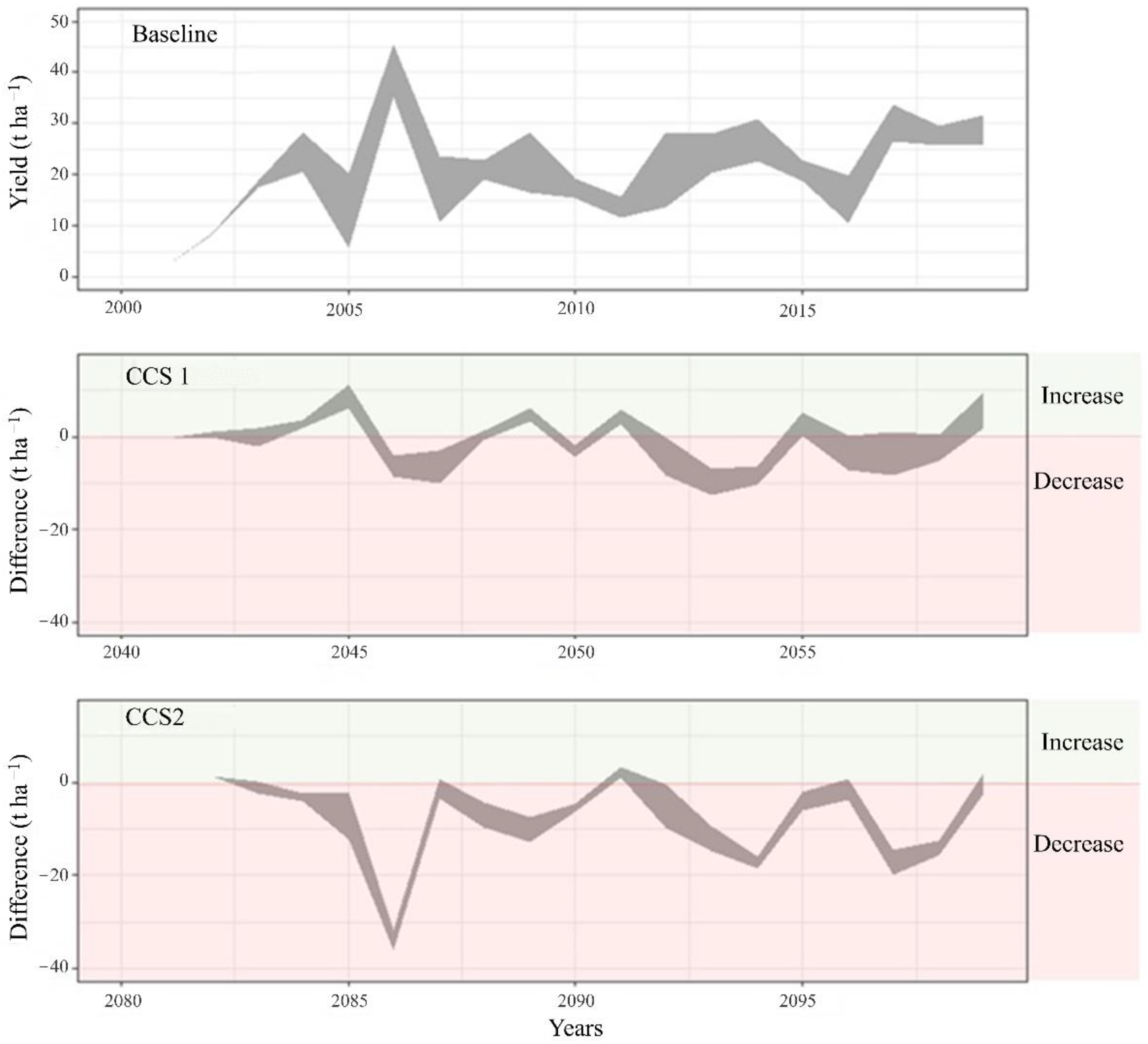
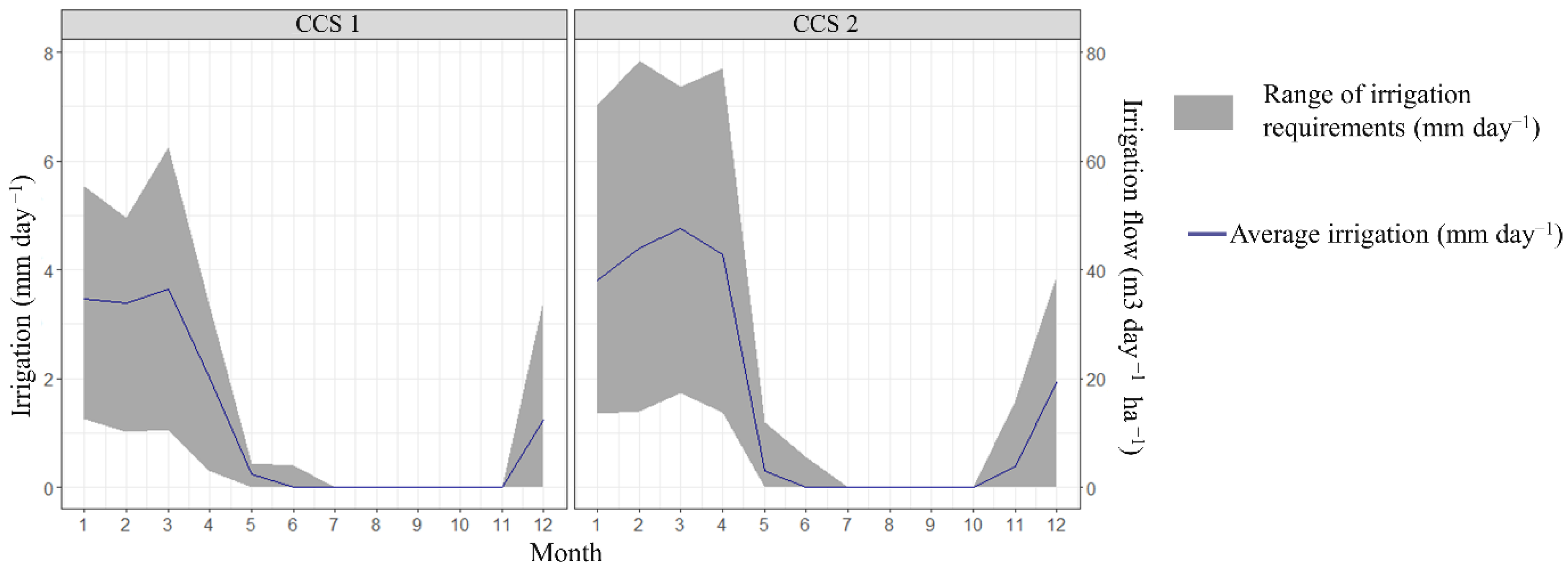
| APB | Depth (cm) | BD (g cm−3) | Texture |
|---|---|---|---|
| 77 | 0.00 | 1.59 | Clay loam |
| 25.00 | 1.35 | Sandy clay loam | |
| 50.00 | 1.22 | Sandy clay loam | |
| 90.00 | 1.22 | Sandy clay loam | |
| 115 | 0.00 | 1.20 | Sandy clay loam |
| 30.00 | 1.20 | Sandy clay loam | |
| 60.00 | 1.30 | Sandy clay loam | |
| 70.00 | 1.30 | Sandy clay loam | |
| 118 | 0.00 | 1.32 | Sandy clay loam |
| 30.00 | 1.33 | Sandy clay loam | |
| 60.00 | 1.30 | Sandy clay loam | |
| 60.00 | 1.35 | Sandy clay loam | |
| 60.00 | 1.40 | Sandy clay loam | |
| 137 | 0.00 | 1.66 | Clay loam |
| 20.00 | 1.50 | Sandy clay loam | |
| 35.00 | 1.30 | Clay loam | |
| 50.00 | 1.30 | Clay loam | |
| 80.00 | 1.40 | Clay loam | |
| 138 | 0.00 | 1.03 | Clay loam |
| 20.00 | 1.03 | Sandy clay loam | |
| 35.00 | 1.20 | Clay loam | |
| 50.00 | 1.20 | Clay loam | |
| 80.00 | 1.20 | Clay loam | |
| 144 | 0.00 | 1.25 | Clay loam |
| 30.00 | 1.22 | Sandy clay loam | |
| 50.00 | 1.22 | Sandy clay loam | |
| 87.50 | 1.22 | Sandy clay loam | |
| 145 | 0.00 | 1.30 | Sandy clay loam |
| 30.00 | 1.22 | Loam | |
| 50.00 | 1.22 | Loam | |
| 87.50 | 1.22 | Loam | |
| 148 | 0.00 | 1.34 | Clay |
| 30.00 | 1.15 | Clay | |
| 50.00 | 1.20 | Clay | |
| 87.50 | 1.30 | Clay |
| Scenario | Period | Rainfall Annual Cumulative (mm) | Temperature (°C) | Radiation (MJ m−2day−1) | ||
|---|---|---|---|---|---|---|
| Maximum | Minimum | Mean | ||||
| Baseline | 2000–2019 | 4224.02 | 31.15 | 23.00 | 27.07 | 16.20 |
| CCS | 2040–2059 | 3989.67 | 32.87 | 24.74 | 28.81 | 16.38 |
| 2080–2099 | 3461.33 | 34.46 | 26.32 | 30.39 | 16.60 | |
Disclaimer/Publisher’s Note: The statements, opinions and data contained in all publications are solely those of the individual author(s) and contributor(s) and not of MDPI and/or the editor(s). MDPI and/or the editor(s) disclaim responsibility for any injury to people or property resulting from any ideas, methods, instructions or products referred to in the content. |
© 2022 by the authors. Licensee MDPI, Basel, Switzerland. This article is an open access article distributed under the terms and conditions of the Creative Commons Attribution (CC BY) license (https://creativecommons.org/licenses/by/4.0/).
Share and Cite
Watson-Hernández, F.; Serrano-Núñez, V.; Gómez-Calderón, N.; Pereira da Silva, R. Quantification and Evaluation of Water Requirements of Oil Palm Cultivation for Different Climate Change Scenarios in the Central Pacific of Costa Rica Using APSIM. Agronomy 2023, 13, 19. https://doi.org/10.3390/agronomy13010019
Watson-Hernández F, Serrano-Núñez V, Gómez-Calderón N, Pereira da Silva R. Quantification and Evaluation of Water Requirements of Oil Palm Cultivation for Different Climate Change Scenarios in the Central Pacific of Costa Rica Using APSIM. Agronomy. 2023; 13(1):19. https://doi.org/10.3390/agronomy13010019
Chicago/Turabian StyleWatson-Hernández, Fernando, Valeria Serrano-Núñez, Natalia Gómez-Calderón, and Rouverson Pereira da Silva. 2023. "Quantification and Evaluation of Water Requirements of Oil Palm Cultivation for Different Climate Change Scenarios in the Central Pacific of Costa Rica Using APSIM" Agronomy 13, no. 1: 19. https://doi.org/10.3390/agronomy13010019
APA StyleWatson-Hernández, F., Serrano-Núñez, V., Gómez-Calderón, N., & Pereira da Silva, R. (2023). Quantification and Evaluation of Water Requirements of Oil Palm Cultivation for Different Climate Change Scenarios in the Central Pacific of Costa Rica Using APSIM. Agronomy, 13(1), 19. https://doi.org/10.3390/agronomy13010019












